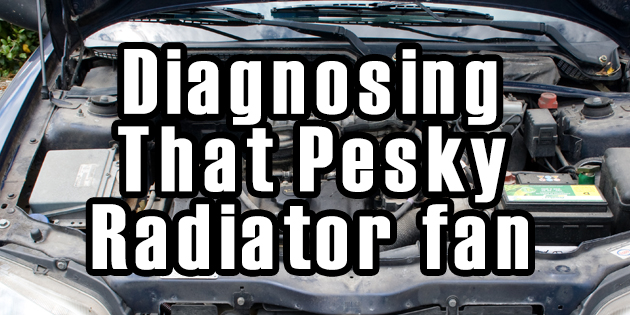Radiator fan failures account for a large percentage of all engine failures due to overheating despite the fact that in many cases, the fan seemed to be working fine.
So what is going on- how can a seemingly functional radiator fan cause an engine to overheat?
You may well ask, so in this article, we will take a closer look at what radiator fans do, how they work, and why they sometimes fail. So let us start at the beginning, by answering the following question.
Related Video: Diagnosing a non-working radiator fan
Why you need a radiator fan
The effectiveness of the cooling system of any liquid-cooled engine depends on the excellent heat absorption properties of both water and air. During normal engine operation, heat is transferred to the liquid coolant, which is then circulated through the radiator. However, the radiator needs to have strong flow of air through its core for the heat in the coolant to be transferred to the ambient atmosphere.
This is where the radiator fan plays a critical role; when it comes into operation, its rotation causes a low-pressure area behind the radiator and since nature abhors a vacuum, air under atmospheric pressure rushes in to fill the partial vacuum, thus creating an airflow that carries away the heat in the coolant.
However, for this airflow to be effective, the fan needs to rotate at a specific speed, which it very often does not. Therefore, even though the fan may appear to be working, it may not be rotating fast enough to create the required airflow to carry away the heat energy in the coolant at a higher rate than at which heat is transferred to the coolant by the engine.
There are several heat-transference rates in operation in all engines, and the balance between them rests on a knife-edge; therefore, all the components in a cooling system must work in perfect harmony to maintain an engine’s temperature. However, there are several components that could cause the radiator fan to stop working when they fail, even though the fan itself may be in perfect working condition. So what can go wrong?
As it happens, there are many things that can go wrong, so let’s look at some possible issues that can affect the working of radiator fans, starting with.
Fan switch failure
In the vast majority of cooling system designs, the fan is controlled by a simple bi-metal switch that is in direct contact with the coolant. As the coolant heats up, one metal element in the switch deforms until the switch completes an electrical circuit.
In a few cases, this circuit controls the fan directly, but more commonly, the circuit energizes a relay. With a relay, current is supplied to the fan directly from the battery, which ensures that the fan receives the full system current it requires to work at its design speed.
Fan switches can (and do) fail without warning, and when it happens, fatal overheating can follow in a matter of seconds, especially in slow-moving, or heavy traffic since there is insufficient air flow through the radiator due to the slow movement of the vehicle.
Fan relay failure
Relays work with electro-magnets that bring two or more contact points into contact to close an electrical circuit. Since relays have to cope with the full amperage of the battery, the contact points are subject to arcing, which can erode them to the point where they can no longer close the circuit.
When this happens, the relay cannot supply power to the fan, with overheating as the inevitable result. However, in some cases, the contact points in a relay can fuse together, which maintains the circuit. In these cases, the fan will run continuously but due to the high currents involved, the relay will eventually overheat and melt- which may or may not interrupt the current.
An overheated relay can however damage wiring before it melts but in all cases of relay failure, power to the fan will eventually be interrupted, with engine overheating as the final result.

Thermostat failure
The primary function of a thermostat is to control and regulate the flow of coolant through an engine. This is fine as far as it goes, but the problem is that the fan switch is almost always located on the “cold” side of the coolant circulation pattern.
In practice, this means that if the thermostat fails and is stuck in the closed position, hot coolant cannot reach the fan switch because there is no circulation of the coolant. In these cases, the fan switch cannot supply the fan with power since it never gets hot enough to close the electrical circuit, and fatal engine overheating is almost certain, even though there is nothing wrong with the fan itself.
However, a thermostat can also be stuck in the open position. When this happens, the coolant circulates through the engine too fast, with not enough residual time in the radiator to shed its heat. Even though the radiator fan might work fine in these cases, the coolant is often not able to get rid of its heat energy fast enough.
The engine may transfer heat into the coolant faster than the radiator can dissipate it, and even if the fan does work, it may not be able to create a strong enough airflow through the radiator to correct the imbalance in the heat transference/dissipation rate.
Resistor failure
Many cooling systems make use of multi-speed fans, with the speed of the fan being controlled by resistors. In these designs, the fan switch is a little more complicated than on single-speed fan systems, but instead of supplying current to a relay, the switch feeds power to resistors.
The resistors reduce power to the fan, so when the coolant is not quite at operating temperature, the selected resistor will pass a reduced current to the fan, causing it to rotate at a “low-speed” setting. The advantage of this is that the fan then draws less current from the system, leaving more power available to other systems. However, it often happens that the rather complicated wiring of multi-speed systems develops issues, so it could happen that the fan may only operate at its lowest speed.
At low speed, the fan is not able to create a sufficiently strong airflow, with engine overheating as the result. Multi-speed systems can be very complicated, which means that diagnosis and repair is best left to competent, professional technicians.
Wiring issues
Although new cars are not immune to wiring problems, radiator fan failures due to issues with wiring are more likely to occur on older vehicles. Long-term exposure to heat, vibration, moisture, and corrosion can cause connections to go bad, or wiring insulation to become brittle and flake off, leaving wires exposed.
Exposed or chafed wiring can cause short circuits than can affect the operation of the radiator fan, while bad connections cause high electrical resistances that can affect how fast a radiator fan rotates- or even prevent a fan from working altogether.
Fan motor failure
Although radiator fan motors are usually reliable and often outlast last the vehicles they are fitted to, they can nevertheless fail for any number of reasons. Voltage spikes, high resistances in control circuits, defective vehicle batteries, bad wiring, short circuits, moisture, corrosion, and even excessive vibration due to damage to the fan itself can all cause a fan motor to fail.
Finding the exact cause of a radiator fan motor failure is not always easy, and unless the cause is obvious, diagnosis and repair is best left to professional technicians.
Viscous radiator fans explained
Of course, not all radiator fans are electrically operated, and a large percentage of vehicles use radiator fans that are driven through viscous couplings. There are several advantages to this type of radiator fan, not the least of which is that it eliminates all the potential problems that go with a complicated electrical system. Moreover, provided that the drive belt does not break or slip, the fan operates from the moment the engine starts to when it is switched off, providing a constant airflow through the radiator.
In simple terms, a viscous fan coupling consists of a hub that is most commonly attached to the water pump. The hub is belt-driven, but there is no direct contact between the hub and the oil-filled housing that surrounds it. Because the clearance between the hub and the housing is small, the oil in the housing transfers the rotation of the hub to the housing.
So what can go wrong? how can viscous fans fail?
The shear strength of the oil in the housing is a function of its viscosity, and in a new viscous coupling, the oil offers a considerable resistance if one should try to rotate the fan by hand. Nevertheless, viscous fans can, and do fail, but for very few reasons. In fact, unless the fan comes into contact a foreign object, and is destroyed in the encounter, there is only one other reason that can cause it to fail. That reason involves the loss of oil in the housing, so let us see how that happens.
Loss of oil in viscous fans
Since the fan consists of parts that can rotate independently, the oil in the housing has to be contained with an oil seal. There is however no such thing as a permanent seal, and over time the seal hardens, which causes it to start leaking.
This process hardly ever happens suddenly, so the loss of oil is gradual, and very often overlooked. Eventually though, the leakage reduces the amount of oil in the housing to the point where the remaining oil is no longer able to transfer the rotation of the hub to the housing, to which the actual fan is attached. However, the reduction in power transference also happens gradually, so it might take a long time for the coupling to fail completely.
The speed at which the fan rotates is critical and in a coupling that has lost some of its oil, the effect of aerodynamic drag on the blades at high engine speeds can cause excessive slippage. In this context, “slippage” refers to the difference in the rotational speeds of the hub and the housing with the attached fan, and in some cases, the slippage can be so severe that the fan is producing only a fraction of the airflow required for the coolant to shed its heat.
Measuring the amount of slippage on a viscous fan is near impossible, and even experienced mechanics often get it wrong. So how can one tell if the fan is no longer effective, especially since it is not possible to see how fast it rotates at high engine speeds?
How to test a viscous fan coupling
About the only reliable way to test a viscous fan is to rotate it by hand when the engine is hot, but switched off- for obvious safety reasons. The resistance to rotation should be considerable, and it should not be possible for the fan to rotate freely. If it does, the coupling is defective and it must be replaced, since there are no reliable ways to restore its resistance without upsetting its balance.
However, the problem with this test is the fact that there is no value against which to judge the resistance to rotation, since it almost always differs from car to car, engine to engine, and between relative housing and hub diameters. Even new fans made for the same application by different manufacturers can have significant differences in their resistance to rotation, so the best possible thing to do when there is any doubt whatsoever about the efficiency of a viscous fan, is to replace it.
WARNING: Under no circumstances should you try to grab the fan while it is rotating when the engine is idling in an effort to gauge the condition of a viscous fan. Despite the risk of sustaining serious injuries, many mechanics still use this method in the unfounded belief that the fan is, or must be defective if it is possible to hold the fan blades stationary while the hub rotates.
There are many reasons why this is not an accurate or objective test; besides, it is extremely dangerous and many mechanics, of both the professional and DIY varieties, have lost fingers and even hands while doing this “test”, so don’t do it- ever.





No Comments